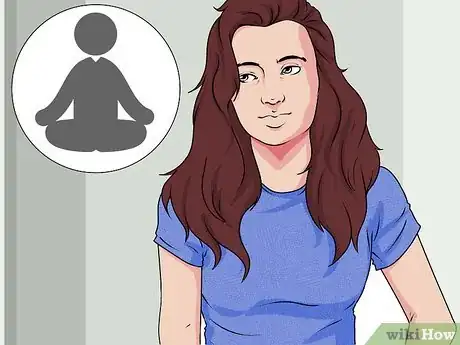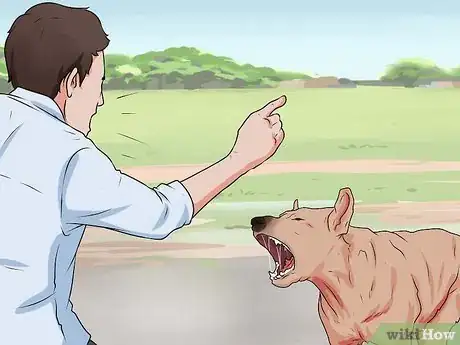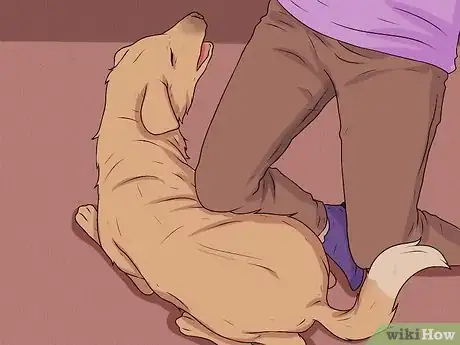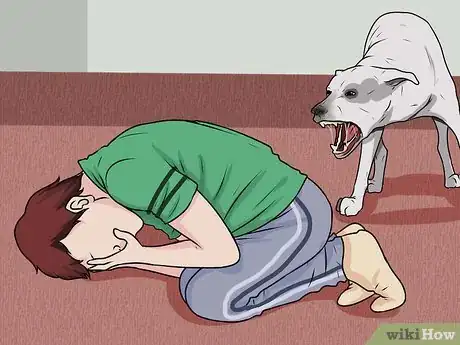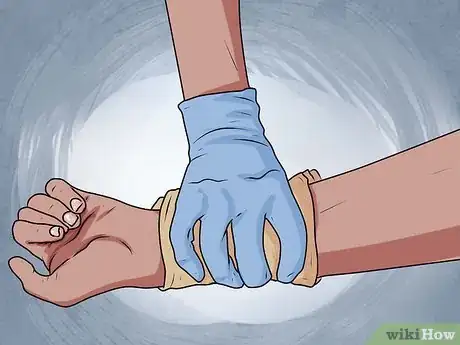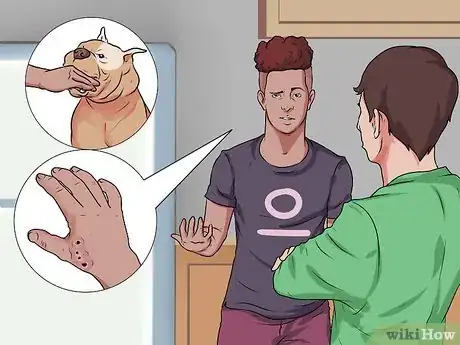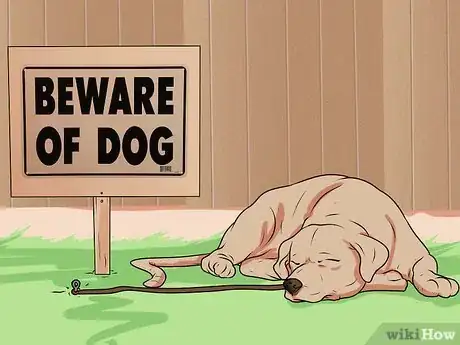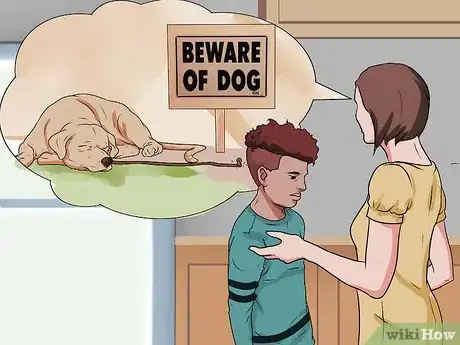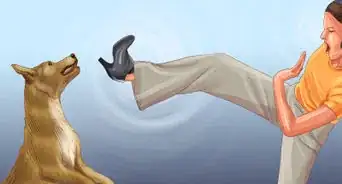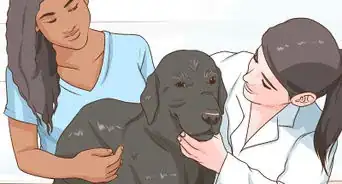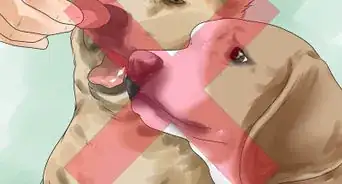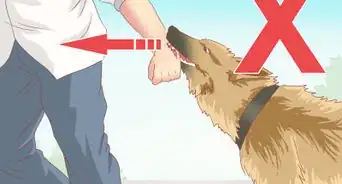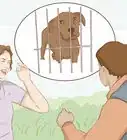This article was co-authored by Pippa Elliott, MRCVS. Dr. Elliott, BVMS, MRCVS is a veterinarian with over 30 years of experience in veterinary surgery and companion animal practice. She graduated from the University of Glasgow in 1987 with a degree in veterinary medicine and surgery. She has worked at the same animal clinic in her hometown for over 20 years.
wikiHow marks an article as reader-approved once it receives enough positive feedback. This article received 14 testimonials and 86% of readers who voted found it helpful, earning it our reader-approved status.
This article has been viewed 1,479,046 times.
Imagine that you're enjoying a run in the park or a bike ride through the neighborhood when, suddenly, an unfamiliar dog runs up to you, snarls, and primes himself to lunge. What should you do? There's a right way and a wrong way to handle a dog attack. Keep yourself safe by staying calm and taking some measures to diffuse the situation.
Steps
Warding Off an Attack
-
1Do not panic. There's some truth to the old adage that dogs and other animals can "sense fear". If you become agitated and run or scream, you may make the dog feel more confident in his attack, or, worse, you may appear threatening to the dog. Neither of these is a good situation to be in.
-
2Make yourself rigid and motionless. When a dog approaches, stand completely still with your hands at your sides, like a tree, and avert your eyes.[1] In many cases the dog will lose interest and walk away if you ignore him.
- Do not wave your arms around or kick with your legs; the dog may perceive these actions as threatening.
- Don't make eye contact, since that could also cause the dog to lunge.
- Stand sideways to the dog and keep him in your peripheral vision instead of facing him and making eye contact. This will signal to the dog that you are not a threat.
- Don't open your hands and arms up to a bite by extending them. Keep your fingers curled into fists to avoid getting them bitten. The dog may come quite close, even sniffing you, without actually biting.
Advertisement -
3Do not try to run away. Running away can awaken the dog's prey instinct to chase and catch animals. He may pursue you vigorously even if his initial intent was just playful. Additionally, you won't be able to outrun most dogs if you're on foot. Even if you are on a bicycle, many dogs will be able to catch up to you.[2]
-
4Distract the dog with another object. If the dog continues to threaten you, offer him something to chew on, such as your backpack or water bottle: anything but your arm or leg. This may distract him enough to give you time to escape.
- You may want to carry treats or toys when traveling in areas known to be home to dangerous dogs. If approached by an angry dog, throw your treats or toy away from you. The dog may go after these instead of you.
Defending and Protecting Yourself
-
1Face the dog and command, "back away." If the dog continues to behave aggressively, and ignoring or pacifying him is no longer working, face him and sternly command him to leave.
- Use a strong, deep, and confident commanding voice.
- Continue to avoid making eye contact.
- The dog may become discouraged or intimidated and leave.
-
2Fight back against an attacking dog. If the dog starts biting you, you've got to defend yourself. Hit or kick the dog in the throat, nose, and the back of the head. This will stun the dog and give you time to get away.[3]
- It's okay to raise your voice at this point. Yell for help as you're fighting back. Hopefully others will hear and come to your aid. However, avoid screaming as this may lead the dog to strengthen his attack.
- If you have a stick or another weapon, you can (and should) use it to hit the dog. Don't hit him over the top of the head, though; most dogs have very thick skulls, so this will only serve to make the dog angrier. If available, mace or pepper spray also work as a good defense against an attacking dog.
- Fight as though your life depends on it, because it does. Dog attacks can be fatal. While you certainly don't want to hurt a dog unnecessarily, you should use force as necessary if you are being seriously attacked.
-
3Use your weight to your advantage. Bring your entire body weight to bear on the animal, specifically pushing down with the hard points of your knees or elbows. Dogs are vicious biters but cannot wrestle, so try to get an advantageous position and break their bones fairly quickly. Get on top of the animal and concentrate force on areas such as the throat or ribs while minding to keep your face out of clawing/biting range.
- If you are looking for a more humane solution and can manage it, straddle the back of the dog with your partial body weight and apply forward pressure to the back of the neck to immobilize the dog until help comes.
-
4Protect your face, chest, and throat. If you fall to the ground during the attack, not only is it more difficult to fight off the angry dog, but vital areas on your torso, head, and neck become more vulnerable to attack. These are the most important spots on your body to protect because bites in these places will inflict the most damage and will have the greatest chance of killing you.
-
5Leave the area slowly and carefully. Once the dog loses interest in you, leave the scene of the attack slowly by backing away without sudden movements.[6] Staying calm and stationary can be a real test of your nerves in such a stressful situation, but it's the best thing to do as long as the dog isn't actually biting you.
Handling the Aftermath
-
1Attend to any wounds. If you are bitten, be sure to take care of any wounds promptly, as even minor bites can cause infection. Perform basic first aid procedures for bites suffered from a dog attack:
- Apply gentle pressure to stop minor bleeding. Use a clean cloth or sterile gauze pad. If bleeding is serious or if it won't stop after several minutes of applying pressure, seek professional medical attention.
- Wash the wound thoroughly. Use warm water and soap to gently cleanse the wound.
- Dress the wound. Use a sterile band-aid (for very small cuts) or sterile bandages for larger lacerations.
- Look closely for signs of infection, including redness, warmth, increasing tenderness, or oozing pus. See a doctor if any of these symptoms arise.
-
2Call the authorities. It's important to determine whether an attacking dog has rabies or a history of aggression. Call the authorities immediately after a dog attack so that the dog can be prevented from harming anyone else and be tested for diseases.
- If the dog that attacked you was a stray, he may attack others, too. Removing him from the area is the best way to ensure the safety of yourself and others.
- For dogs with owners nearby, how you handle the situation after the attack has been diffused is up to you. If you've been hurt, you may want to take legal action. Many states have laws holding owners responsible for the actions of their dogs.
-
3See a medical professional promptly. If you were bitten by an unknown dog, a dog that was later found to have rabies, or a dog that appeared to be foaming at the mouth, it's imperative that you see a doctor right away to get preventative treatment for the deadly disease rabies.
- The rabies shot sequence, if it is necessary, should be started as soon as possible after the bite.
- Most European countries are considered to be “rabies-free,” so a shot is not likely to be necessary in the event of an attack that takes place in Europe.
- If you haven't had a tetanus shot in the past 5 years, you may require additional preventative tetanus treatments.
- In general, any significant wounds from a dog attack should be examined by a medical professional.
Taking Precautions Against Attacks
-
1Look for warning signs. Most dogs are not aggressive, but, rather, just curious or defending what they perceive as their territory. Thus, to avoid unnecessary conflict, it is important to be able to tell if a dog is just playing or is being truly aggressive. While some breeds have been singled out as being particularly vicious, any mid-size and large dog breed can be dangerous, so do not ignore warning signs because you think a certain breed is harmless or friendly. Watch for common signs of aggression (and non-aggression):[7]
- Growling, snarling, and baring teeth are obvious displays of aggression and should be treated as such.
- An angry dog may show the whites of his eyes, especially if these aren't normally visible.
- Pulled-back ears laying flat against the head are a telltale sign of aggression, whereas normal floppy or elevated ears usually signal a dog's nonchalance.
- If the dog approaches you with its body relaxed and with a sloping curve in its midsection, the dog is probably not going to attack.
- A dog whose body is tense, straight and stiff (head, shoulders and hips aligned) could mean that the dog might attack.
- A loping gait means the dog is playful and checking you out. An even, steady run means the dog may be dangerous.
-
2Avoid aggravating a dog. Most dog attacks are the result of insufficient containment of the dog, poor training, or taunting. Unfortunately, the world will never be rid of bad owners, so it is wise to be prepared. Common sense should tell you not to aggravate any kind of animal.
- Never irritate a dog who's eating or caring for her pups. Dogs are extra-protective during these times.
- Avoid smiling at the dog. You may think you are putting on a friendly face with a big toothy smile, but an aggressive dog sees you baring your teeth for a fight.
- Dogs that are chained or tethered to a stationary object for extended periods of time are more likely to be aggressive, so do not come within their reach.
-
3Assume all unknown dogs are threats. In general, the best policy when it comes to dog attacks is to do everything you can to avoid them in the first place. If you see a dog that may be dangerous, stay away.
- Report any dangerous-looking dogs or possible strays in your neighborhood to the authorities.
- Teach your children never to approach unfamiliar dogs until they are sure they are safe.
- By giving all unknown dogs a wide berth until you find evidence that they are safe, you can avoid the majority of dangerous dog encounters.
Expert Q&A
-
QuestionWhy would a dog attack his owner of 10 years?
 Pippa Elliott, MRCVSDr. Elliott, BVMS, MRCVS is a veterinarian with over 30 years of experience in veterinary surgery and companion animal practice. She graduated from the University of Glasgow in 1987 with a degree in veterinary medicine and surgery. She has worked at the same animal clinic in her hometown for over 20 years.
Pippa Elliott, MRCVSDr. Elliott, BVMS, MRCVS is a veterinarian with over 30 years of experience in veterinary surgery and companion animal practice. She graduated from the University of Glasgow in 1987 with a degree in veterinary medicine and surgery. She has worked at the same animal clinic in her hometown for over 20 years.
Veterinarian If his aggression is out of character, in a dog of this age you need to consider that he might be in pain. Sore arthritic joints, bad teeth, poor sight, or an ear infection are examples of conditions that can make the dog feel more defensive and less tolerant. Get him checked by a vet, as treatment may be all that's needed to resolve the issue.
If his aggression is out of character, in a dog of this age you need to consider that he might be in pain. Sore arthritic joints, bad teeth, poor sight, or an ear infection are examples of conditions that can make the dog feel more defensive and less tolerant. Get him checked by a vet, as treatment may be all that's needed to resolve the issue. -
QuestionWhat should I do if I think a large dog might attack me and/or my Chihuahua while we are going for a walk?
 Pippa Elliott, MRCVSDr. Elliott, BVMS, MRCVS is a veterinarian with over 30 years of experience in veterinary surgery and companion animal practice. She graduated from the University of Glasgow in 1987 with a degree in veterinary medicine and surgery. She has worked at the same animal clinic in her hometown for over 20 years.
Pippa Elliott, MRCVSDr. Elliott, BVMS, MRCVS is a veterinarian with over 30 years of experience in veterinary surgery and companion animal practice. She graduated from the University of Glasgow in 1987 with a degree in veterinary medicine and surgery. She has worked at the same animal clinic in her hometown for over 20 years.
Veterinarian Remain calm, and do not show fear. Have your dog stay calm, as any aggressive behavior from him may trigger the large dog to attack. Plan ahead, and consider carrying a walking stick to fend off the large dog if he attacks. If you suspect the dog will attack, equip yourself with some pepper spray to use to defend yourself (but be careful of the wind direction so that you don't hurt yourself). Look around you for the owner, and demand they immediately call their dog and restrain it.
Remain calm, and do not show fear. Have your dog stay calm, as any aggressive behavior from him may trigger the large dog to attack. Plan ahead, and consider carrying a walking stick to fend off the large dog if he attacks. If you suspect the dog will attack, equip yourself with some pepper spray to use to defend yourself (but be careful of the wind direction so that you don't hurt yourself). Look around you for the owner, and demand they immediately call their dog and restrain it. -
QuestionShould I report the owner of a dog that attacked me but didn't hurt me?
 Pippa Elliott, MRCVSDr. Elliott, BVMS, MRCVS is a veterinarian with over 30 years of experience in veterinary surgery and companion animal practice. She graduated from the University of Glasgow in 1987 with a degree in veterinary medicine and surgery. She has worked at the same animal clinic in her hometown for over 20 years.
Pippa Elliott, MRCVSDr. Elliott, BVMS, MRCVS is a veterinarian with over 30 years of experience in veterinary surgery and companion animal practice. She graduated from the University of Glasgow in 1987 with a degree in veterinary medicine and surgery. She has worked at the same animal clinic in her hometown for over 20 years.
Veterinarian This depends how serious the attack was. If you feel the dog is a real danger to other people and the owner is not taking sufficient steps to control the animal, then report them. Unless actual harm was done, it's unlikely they will be prosecuted, but inspectors may call to discuss appropriate control and training, which could save another person from being attacked in the future.
This depends how serious the attack was. If you feel the dog is a real danger to other people and the owner is not taking sufficient steps to control the animal, then report them. Unless actual harm was done, it's unlikely they will be prosecuted, but inspectors may call to discuss appropriate control and training, which could save another person from being attacked in the future.
Warnings
- The owners of aggressive dogs can be worse than the dogs. If you have to injure or kill an attacking dog, get away from the area and call the police as soon as possible.⧼thumbs_response⧽
- Every dog is different, and dogs will sometimes react in unpredictable ways. These tips will help you escape danger in most situations, but you may have to adapt to an attack on-the-fly, so be alert.⧼thumbs_response⧽
- If the dog appears sick or if he falls ill within 10 days of the incident, the dog should be tested for rabies immediately. If the dog tests positive you must go through a series of rabies shots.⧼thumbs_response⧽
- Remember that some breeds "wag late" (for instance, some super-friendly Akitas only start wagging 6 ft (2m) away), so don't assume an approaching dog is going to attack you because it's not wagging its tail.⧼thumbs_response⧽
- Be careful when you use pepper spray or mace. The odds of hitting dog in the face before it can attack you are small, and if you're downwind, the over-spray will affect you. Even if you hit the dog in the face, you are likely just to make the dog angry, especially if it's feral.⧼thumbs_response⧽
References
- ↑ http://www.dailykos.com/story/2012/01/31/1060335/-Surviving-a-Dog-Attack#
- ↑ http://www.dailykos.com/story/2012/01/31/1060335/-Surviving-a-Dog-Attack#
- ↑ http://omaha.net/articles/dog-attacks-and-your-safety
- ↑ http://fox40.com/2013/04/13/how-to-survive-a-dog-attack/
- ↑ http://www.dailykos.com/story/2012/01/31/1060335/-Surviving-a-Dog-Attack#
- ↑ http://www.dailykos.com/story/2012/01/31/1060335/-Surviving-a-Dog-Attack#
- ↑ http://www.humanesociety.org/animals/dogs/tips/avoid_dog_bites.html
About This Article
Being attacked by a dog can be really scary, but if you stay calm and avoid sudden movements, the dog should lose interest in you. If an aggressive dog approaches you, never run away or make loud noises. This can scare it or make it chase you. Instead, stand still with your hands open by your sides and look away from the dog. If it starts biting or attacking you, yell “Back” or “Stop.” If it keeps attacking you, try to hit or kick it in the face to stun it. You can also use your weight to your advantage by digging your knee or elbow into its throat or ribs. If you fall on the ground, roll onto your stomach and bring your knees into your chest to protect your vital organs. When the dog loses interest in you, slowly and calmly back away from the area until you’re safe. For more tips from our Veterinary co-author, including how to spot a potentially dangerous dog, read on.
